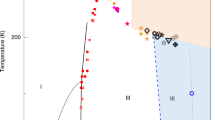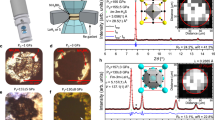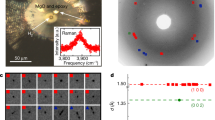Abstract
Molecular hydrogen is expected to exhibit metallic properties under megabar pressures. This metal is predicted to be superconducting with a very high critical temperature, Tc, of 200–400 K (ref. 1), and it may acquire a new quantum state as a metallic superfluid and a superconducting superfluid2. It may potentially be recovered metastably at ambient pressures3. However, experiments carried out at low temperatures, T<100 K (refs 4, 5), showed that at record pressures of 300 GPa, hydrogen remains in the molecular insulating state. Here we report on the transformation of normal molecular hydrogen at room temperature (295 K) to a conductive and metallic state. At 200 GPa the Raman frequency of the molecular vibron strongly decreased and the spectral width increased, evidencing a strong interaction between molecules. Deuterium behaved similarly. Above 220 GPa, hydrogen became opaque and electrically conductive. At 260–270 GPa, hydrogen transformed into a metal as the conductance of hydrogen sharply increased and changed little on further pressurizing up to 300 GPa or cooling to at least 30 K; and the sample reflected light well. The metallic phase transformed back at 295 K into molecular hydrogen at  200 GPa. This significant hysteresis indicates that the transformation of molecular hydrogen into a metal is accompanied by a first-order structural transition presumably into a monatomic liquid state. Our findings open an avenue for detailed and comprehensive studies of metallic hydrogen.
200 GPa. This significant hysteresis indicates that the transformation of molecular hydrogen into a metal is accompanied by a first-order structural transition presumably into a monatomic liquid state. Our findings open an avenue for detailed and comprehensive studies of metallic hydrogen.
This is a preview of subscription content, access via your institution
Access options
Subscribe to this journal
Receive 12 print issues and online access
$259.00 per year
only $21.58 per issue
Buy this article
- Purchase on Springer Link
- Instant access to full article PDF
Prices may be subject to local taxes which are calculated during checkout




Similar content being viewed by others
References
Ashcroft, N. W. Metallic hydrogen: A high-temperature superconductor? Phys. Rev. Lett. 21, 1748–1750 (1968).
Babaev, E., Sudbo, A. & Ashcroft, N. W. A superconductor to superfluid phase transition in liquid metallic hydrogen. Nature 431, 666–668 (2004).
Brovman, E. G., Kagan, Y. & Kholas, A. Structure of metallic hydrogen at zero pressure. Sov. Phys. JETP 34, 1300–1315 (1972).
Loubeyre, P., Occelli, F. & LeToullec, R. Optical studies of solid hydrogen to 320 GPa and evidence for black hydrogen. Nature 416, 613–617 (2002).
Akahama, Y., Kawamura, H., Hirao, N., Ohishi, Y. & Takemura, K. Raman scattering and x-ray diffraction experiments for phase III of solid hydrogen. J. Phys.: Conf. Ser. 215, 012056 (2010).
Wigner, E. & Huntington, H. B. On the possibility of a metallic modification of hydrogen. J. Chem. Phys. 3, 764–770 (1935).
Johnson, K. A. & Ashcroft, N. W. Structure and bandgap closure in dense hydrogen. Nature 403, 632–635 (2000).
Mao, H. K. & Hemley, R. J. Ultrahigh pressure transitions in solid hydrogen. Rev. Mod. Phys. 66, 671–692 (1994).
Hanfland, M., Hemley, R. J. & Mao, H. K. Optical absorption measurements of hydrogen at megabar pressures. Phys. Rev. B 43, 8767–8770 (1991).
Eggert, J. H. et al. Absorption and reflectance in hydrogen up to 230 GPa: Implications for metallization. Phys. Rev. Lett. 66, 193–196 (1991).
Narayana, C., Luo, H., Orloff, J. & Ruoff, A. L. Solid hydrogen at 342 GPa: no evidence for an alkali metal. Nature 393, 46–49 (1998).
Vereshchagin, L. F., Yakovlev, E. N. & Timofeev, Y. A. Possibility of transition of hydrogen into the metallic state. Lett. JETP 21, 85–86 (1975).
Eremets, M. I., Struzhkin, V. V., Mao, H. K. & Hemley, R. J. Exploring superconductivity in low-Z materials at megabar pressures. Physica B 329, 1312–1316 (2003).
Weir, S. T., Mitchell, A. C. & Nellis, W. J. Metallization of fluid molecular hydrogen at 140 GPa (1.4 Mbar). Phys. Rev. Lett. 76, 1860–1863 (1996).
Hawke, P. S. et al. Observation of electrical conductivity of isentropically compressed hydrogen at megabar pressures. Phys. Rev. Lett. 41, 994–997 (1978).
Pavlovskii, A. I. et al. Proc. 4th International Conference on Megagauss Magnetic Field Generation and Related Topics, Megagauss Technology and Pulsed Power Applications 255–262 (Pergamon, 1987).
Boriskov, G. V. et al. Conductivity and permittivity of hydrogen under isentropic magnetic compression up to 3 Mbar. J. Low Temp. Phys. 159, 307–310 (2010).
Loubeyre, P. et al. X-ray diffraction and equation of state of hydrogen at megabar pressures. Nature 383, 702–704 (1996).
Akahama, Y. et al. Evidence from x-ray diffraction of orientational ordering in phase III of solid hydrogen at pressures up to 183 GPa. Phys. Rev. B 82, 060101(R) (2010).
Pickard, C. J. & Needs, R. J. Structure of phase III of solid hydrogen. Nature Phys. 3, 473–476 (2007).
Hemley, R. J., Mao, H. K. & Shu, J. F. Low-frequency vibrational dynamics and structure of hydrogen at megabar pressures. Phys. Rev. Lett. 65, 2670–2673 (1990).
Edwards, P. P. & Sienko, M. J. What is a metal? Int. Rev. Phys. Chem. 3, 83–137 (1983).
Stadele, M. & Martin, R. M. Metallization of molecular hydrogen: Predictions from exact-exchange calculations. Phys. Rev. Lett. 84, 6070–6073 (2000).
Bonev, S. A., Schwegler, E., Ogitsu, T. & Galli, G. A quantum fluid of metallic hydrogen suggested by first-principles calculations. Nature 431, 669–672 (2004).
Morales, M. A., Pierleonib, C., Schwegler, E. & Ceperley, D. M. Evidence for a first-order liquid–liquid transition in high-pressure hydrogen from ab initio simulations. Proc. Natl Acad. Sci. 107, 12803 (2010).
Tamblyn, I. & Bonev, S. A. Structure and phase boundaries of compressed liquid hydrogen. Phys. Rev. Lett. 104, 065702 (2010).
Eremets, M. I. & Trojan, I. A. Evidence of maximum in the melting curve of hydrogen at megabar pressures. Lett. JETP 89, 198–203 (2009).
Baer, B. J., Chang, M. E. & Evans, W. J. Raman shift of stressed diamond anvils: Pressure calibration and culet geometry dependence. J. Appl. Phys. 104, 034504 (2008).
Baer, B. J., Evans, W. J. & Yoo, C-S. Coherent anti-stokes Raman spectroscopy of highly compressed solid deuterium at 300 K: Evidence for a new phase and implications for the band gap. Phys. Rev. Lett. 98, 235503 (2007).
Attaccalite, C. & Sorella, S. Stable liquid hydrogen at high pressure by a novel ab initio molecular-dynamics calculation. Phys. Rev. Lett. 100, 114501 (2008).
Acknowledgements
Support provided by the Max Planck Society, DFG under the grant SPP 1236, and the European Research Council under the 2010-Advanced Grant 267777 is gratefully acknowledged. We appreciate the valuable comments and support of M. O. Andreae.
Author information
Authors and Affiliations
Contributions
The authors contributed equally.
Corresponding authors
Ethics declarations
Competing interests
The authors declare no competing financial interests.
Supplementary information
Supplementary Information
Supplementary Information (PDF 1117 kb)
Rights and permissions
About this article
Cite this article
Eremets, M., Troyan, I. Conductive dense hydrogen. Nature Mater 10, 927–931 (2011). https://doi.org/10.1038/nmat3175
Received:
Accepted:
Published:
Issue Date:
DOI: https://doi.org/10.1038/nmat3175
This article is cited by
-
Magnetic field screening in hydrogen-rich high-temperature superconductors
Nature Communications (2022)
-
Materials under high pressure: a chemical perspective
Applied Physics A (2022)
-
Hydrides under High Pressure
Journal of Superconductivity and Novel Magnetism (2022)
-
Superconductivity up to 243 K in the yttrium-hydrogen system under high pressure
Nature Communications (2021)
-
High-temperature superconductivity on the verge of a structural instability in lanthanum superhydride
Nature Communications (2021)



